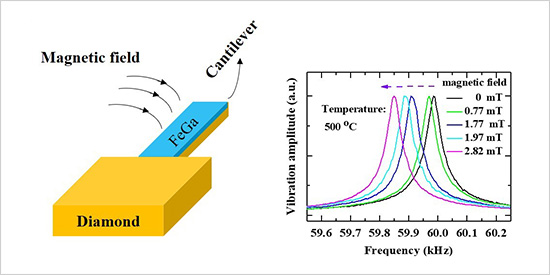Development of a Diamond MEMS Magnetic Sensor Capable of Operating at High Temperatures
—Stable and Sensitive Even at 500℃, the Technology May Lead to Sensors that Can Operate in Extreme Environments, Such as Internal Combustion Engines and Oil Exploration Sites—
2020.11.13
National Institute for Materials Science (NIMS)
NIMS has succeeded in developing a highly sensitive diamond-based magnetic sensor capable of operating stably and energy efficiently at temperatures as high as 500°C.
Abstract
- NIMS has succeeded in developing a highly sensitive diamond-based magnetic sensor capable of operating stably and energy efficiently at temperatures as high as 500°C. This success was achieved by overcoming the drawbacks of existing high-temperature-compatible magnetic sensors through theoretical investigation of the mechanisms enabling diamonds to function stably at high temperatures.
- The development of magnetic sensors capable of operating stably at high temperatures is attracting a great deal of interest. These sensors could meet various needs, including engine speed sensing in aircraft and automobiles and measurement of geomagnetic changes and detection of magnetic minerals during petroleum exploration. They will also be needed to put Japan's vision for a super-smart society (the Society 5.0 initiative) into practice. Existing high-temperature-compatible magnetic sensors have several disadvantages, including large size, poor energy efficiency, low sensitivity and instability at high temperatures. To address these issues, efforts have been made to develop magnetic sensors that employ a microscale, highly sensitive, energy efficient, multi-sensing MEMS (microelectromechanical system) technology. This research group has succeeded in developing an extremely sensitive MEMS sensor using a diamond with the highest hardness and the highest Young's modulus value ever recorded for a material. Diamonds have been known to have a wide bandgap of 5.5 electronvolts, suggesting that they may be resistant to electronic excitation even when exposed to high temperatures, making them a promising material for the development of highly sensitive sensors capable of operating stably in hot conditions. To test this assumption, the group conducted theoretical studies and experiments.
- As a result, the group demonstrated theoretically and experimentally that diamonds with deep-level defects can operate as stable sensor components at temperatures as high as 700°C. The group then succeeded in developing a MEMS magnetic sensor capable of operating at 500°C by combing the diamond with a magnetostrictive material that can deform elastically in response to external magnetic fields at high temperatures. The sensor exhibited very high magnetic sensitivity (10nT/√Hz) at 500°C.
- This new technology may serve as an effective magnetic sensor for use under extreme conditions, such as internal combustion engines, petroleum and mineral exploration sites, nuclear reactors (within which material degradation needs to be inspected) and outer space.
- This project was carried out by Meiyong Liao (Principal Researcher, Research Center for Functional Materials (RCFM), NIMS), Zilong Zhang (Trainee, RCFM, NIMS), Huanying Sun (Trainee, RCFM, NIMS), Liwen Sang (Independent Scientist, International Center for Materials Nanoarchitectonics, NIMS), Satoshi Koizumi (Group Leader, RCFM, NIMS) and Masaya Toda (Associate Professor, Tohoku University). This project was supported in part by the JSPS Grants-in-Aid for Scientific Research (B) (grant numbers: 15H03999 and 20H02212) and the TIA collaborative research program "Kakehashi." This research was published in Physical Review Letter on November 12, 2020, local time, and in ACS Applied Materials & Interfaces (vol. 12, issue 20).

Figure. Structure of the cantilever in the diamond MEMS magnetic sensor (left) and magnetic sensitivity of the sensor at a high temperature (500°C)
Related files
- Research Center for Functional Materials
Contact information
(Regarding this research)
-
Meiyong Liao
Principal Researcher,
Wide Bandgap Semiconductors Group,
Electric and Electronic Materials Field,
Research Center for Functional Materials,
National Institute for Materials Science
Tel: +81-29-860-4508
Fax: +81-29-851-4005
E-Mail: Meiyong.Liao=nims.go.jp
(Please change "=" to "@") -
Satoshi Koizumi
Group Leader,
Wide Bandgap Semiconductors Group,
Electric and Electronic Materials Field,
Research Center for Functional Materials,
National Institute for Materials Science
Tel: +81-29-860-4310
Fax: +81-29-851-4005
E-Mail: Koizumi.Satoshi=nims.go.jp
(Please change "=" to "@")
(General information)
-
Public Relations Office
National Institute for Materials Science
Tel: +81-29-859-2026
Fax: +81-29-859-2017
E-Mail: pressrelease=ml.nims.go.jp
(Please change "=" to "@")
Recent Press Release
-
Simultaneous Imaging of Intracellular DNA and RNA Using Harmless Light
2025.10.27
-
Development of an AI Device Using Ion Gel and Graphene That Dramatically Streamlines Machine Learning Computations
2025.10.14
-
Demonstrating a Novel Method to Modulate Heat Flow Through the Collective Motion of Spins
2025.10.06
